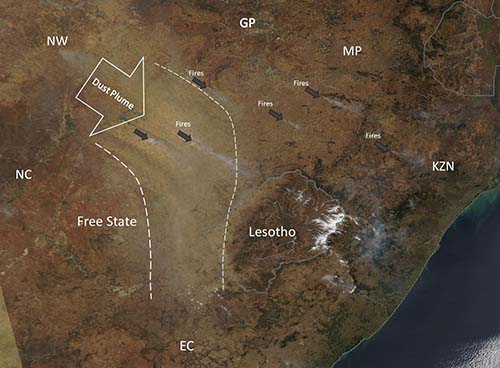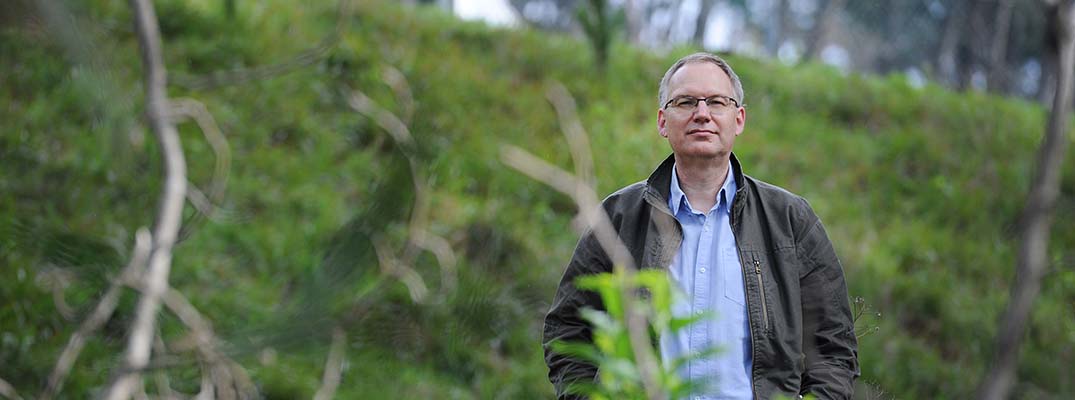The sources of South Africa’s dust emissions could pose a threat to food security.
A new paper in the Aeolian Research journal titled “South Africa’s agricultural dust sources and events from MSG SEVIRI” points to windborne dust from large tracts of northern Free State croplands, which were decimated by the 2015/2016 drought, as a cause for South Africa’s dust.
While in neighbouring dry countries of Botswana and Namibia, dust originates mostly from dry rivers and lakes, South Africa is unusual because most of its dust originates from exposed agricultural areas – especially during drought.
It’s a red flag for food security as the country relies on the Free State mielielande (maize fields) for staple foods.
Understanding dust emission dynamics originating from farming in drylands is crucial, says Associate Professor Frank Eckardt from the University of Cape Town’s (UCT) Department of Environmental and Geographical Science and co-author of the paper.
Once lost, soil is hard to replace; its formation takes aeons, with erosion by wind and water usually outstripping soil production.
“The fine soil fraction that’s dispersed by windstorms adds quality to soil. It holds the nutrients and the moisture. You do not want to lose the fine (silt) fraction.”
In time, “deflated soils” become sandy and harder to farm.
“Sandy soils can absorb water but may not be good at holding moisture,” Eckardt adds. “They may also hold [less] carbon and [fewer] nutrients.”
Though framers try to keep some stubble or cover crop on these denuded farmlands, efforts are patchy. And livestock (the province has large dairy herds) trampling and grazing in a degraded field can cause more damage.
“It’s not only about responding to the impacts mentioned; studying the impact of dust emissions helps to secure food production in the best possible conditions using these marginal lands – a resource that’s becoming increasingly scarce,” Eckardt says.

A major dust plume originates from the agricultural areas in the Free
State on 23 September 2008. The sources and trajectory here are typical
for South Africa major dust events. Small fire smoke plumes are seen
further east.
Source: NASA MODIS Satellite Image
Dust plumes have a detectable range in satellite imagery of hundreds of kilometres. Eckardt’s work is underpinned by a satellite image record of more than a decade.
For his research paper, Eckardt used the Meteosat Second Generation Spinning Enhanced Visible and Infrared Imager image record from 2006 to 2016, examining 334 497 images. From these images, Eckardt can see dust plumes being initiated, growing and travelling – sometimes for many hours.
“The resolution or detail is quite coarse, but we can spot the sources with an accuracy of a few kilometres. Our main interest though is on the source areas, which appear to be persistent and relatively small – on a national scale at least. The western Free State is clearly the most emissive dust-producing area in South Africa.”
The Free State’s dust emission season from June to January overlaps with the dry season and coincides with the maize harvest period. “2015 and 2016 saw almost half of all event days in the 11-year record, which was matched by a severe drought index and stronger winds.”
Eckardt says this period was accompanied by a below-average vegetation coverage of the cropland areas. The then Department of Agriculture, Forestry and Fisheries’ crop data reported a notable decline in Free State maize cover from 1,2-million to 0,6-million hectares and an increase in fallow land from 140 000 to 790 000 hectares over the same time span.
The research is also part of a four-year, four-partner South African–Swiss project with UCT, the University of Pretoria, the Agricultural Research Council and the University of Basel. This will look at the environmental thresholds for the generation of dust (wind, soil moisture, soil crust) in relation to farmland management. It will also study the extent to which farmland dust sources affect ecosystem services, public health and, potentially, climate.
Featured pic: Associate Professor Frank Eckardt
Photo credit: Lerato Maduna/UCT

